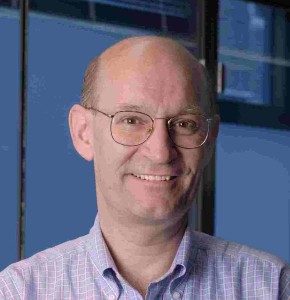Meeting Program — October 2013
Raymond J. Gorte
Department of Chemical & Biomolecular Engineering
University of Pennsylvania
Philadelphia, PA 19104
Abstract — Ceria-supported metal catalysts are widely used in automotive emissions control, where ceria provides “Oxygen Storage Capacitance”. Ceria-supported metals also have potential for a large number of other applications, ranging from methane oxidation to the water-gas-shift reaction, due to the enhanced properties that ceria imparts. However, the activities and stabilities depend strongly on the structure of the ceria and whether or not it is mixed with a second oxide. Catalyst properties are also affected by how catalytic metals interact with the support.
In this talk, I will first discuss work aimed at understanding the role that ceria plays in oxygen storage and demonstrate that the thermodynamic redox properties of catalytic forms of ceria differ from that of bulk ceria. I will then talk about our efforts to maximize the interactions between catalytic metals and ceria, as well as prevent sintering of the metal particles, through the preparation of core-shell catalysts deposited onto a functionalized-alumina support. These core-shell catalysts exhibit exceptional activity for methane oxidation, with impressive stability at high temperatures.
 Biography — Raymond J. Gorte joined the faculty at the University of Pennsylvania in 1981 after receiving his PhD in Chemical Engineering from the University of Minnesota. He is currently the Russell Pearce and Elizabeth Crimian Heuer Professor of Chemical & Biomolecular Engineering, with a secondary appointment in Materials Science & Engineering. Since joining Penn, Ray has served as Chairman of Chemical Engineering from 1995 to 2000 and was the Carl V. S. Patterson Professor of Chemical Engineering from 1996 through 2001. He received the 1997 Parravano Award of the Michigan Catalysis Society, the 1998 Philadelphia Catalysis Club Award, the 1999 Paul Emmett Award of the North American Catalysis Society, the 2001 Penn Engineering Distinguished Research Award, and the 2009 AIChE Wilhelm Award. He has served as Chairman of the Gordon Conference on Catalysis (1998) and Program Chairman of the 12th International Zeolite Conference (1998). He is an Associate Editor of the Journal of the Electrochemical Society. His present research interests are focused on electrodes for solid-oxide fuel cells and the catalytic properties of core-shell materials. He is also known for his research on zeolite acidity and for metal-support effects, especially with ceria-supported precious metals, used in automotive emissions control.
Biography — Raymond J. Gorte joined the faculty at the University of Pennsylvania in 1981 after receiving his PhD in Chemical Engineering from the University of Minnesota. He is currently the Russell Pearce and Elizabeth Crimian Heuer Professor of Chemical & Biomolecular Engineering, with a secondary appointment in Materials Science & Engineering. Since joining Penn, Ray has served as Chairman of Chemical Engineering from 1995 to 2000 and was the Carl V. S. Patterson Professor of Chemical Engineering from 1996 through 2001. He received the 1997 Parravano Award of the Michigan Catalysis Society, the 1998 Philadelphia Catalysis Club Award, the 1999 Paul Emmett Award of the North American Catalysis Society, the 2001 Penn Engineering Distinguished Research Award, and the 2009 AIChE Wilhelm Award. He has served as Chairman of the Gordon Conference on Catalysis (1998) and Program Chairman of the 12th International Zeolite Conference (1998). He is an Associate Editor of the Journal of the Electrochemical Society. His present research interests are focused on electrodes for solid-oxide fuel cells and the catalytic properties of core-shell materials. He is also known for his research on zeolite acidity and for metal-support effects, especially with ceria-supported precious metals, used in automotive emissions control.